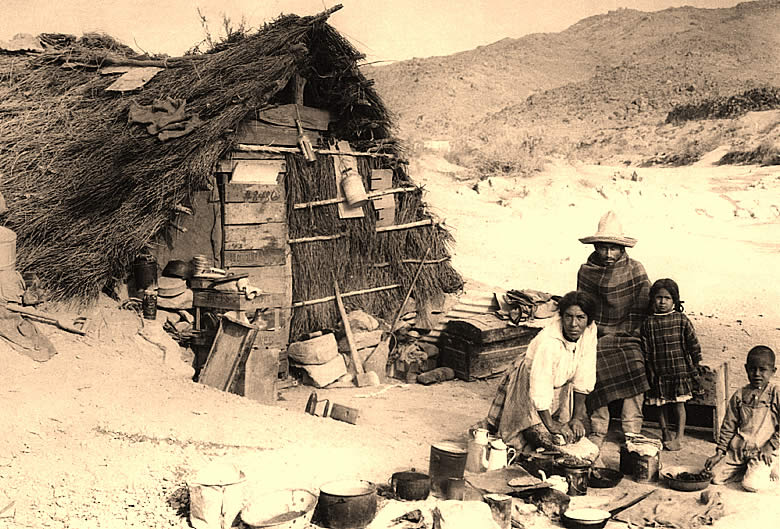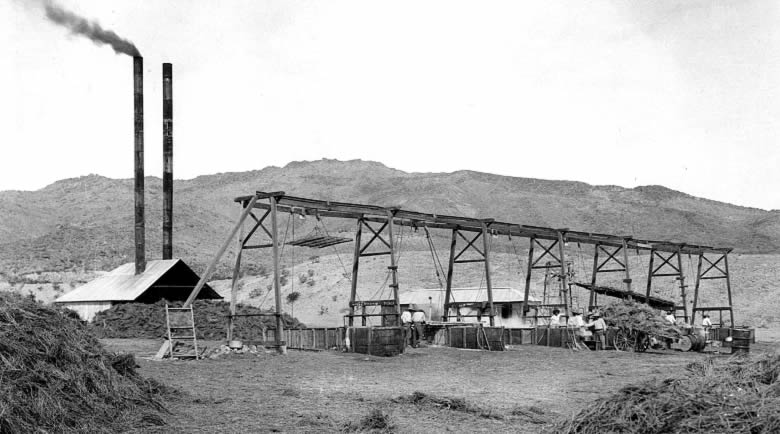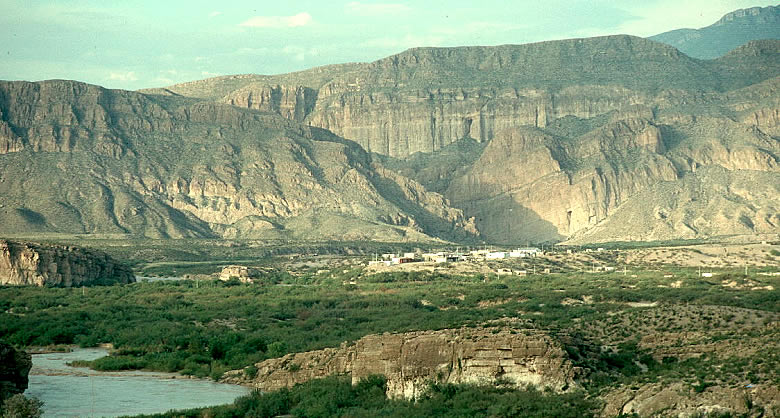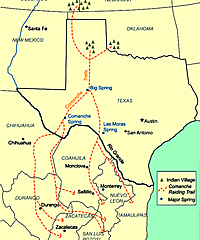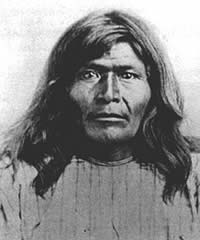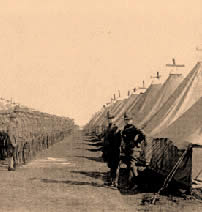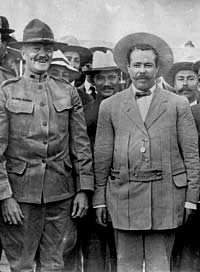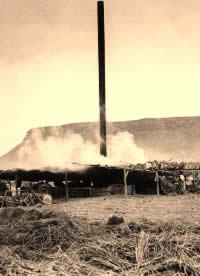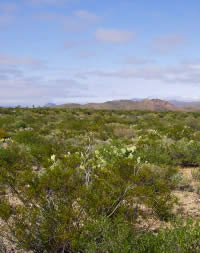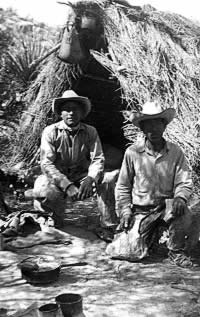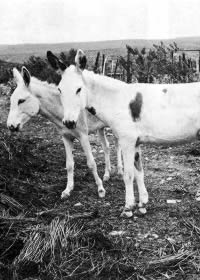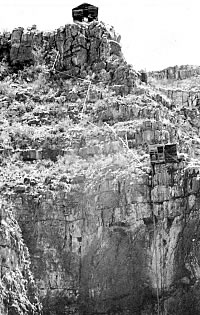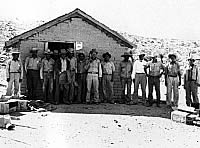Smuggling Wax
"For the Mexicans it's smuggling, but for
us it's importing." Wax has always flowed across the
Rio Grande either because buyers on this side would pay more
than the Banco or because cash was more quickly accessible
from Texas buyers. It is illegal under Mexican law to smuggle
wax out of Mexico, but not illegal under United States statutes
to bring it into this country for marketing if it is declared
with customs. Heavily laden burros have brought wax into Texas
at various places, including Stillwell's Crossing, Reagan
Canyon, La Linda, Boquillas, San Vicente, Solis, Santa Elena,
Lajitas, El Mulato, Presidio, and Candelária. It is
estimated that as many as 1700 tons of wax have been smuggled
across the Texas border in some years.
One informant described participating in a nocturnal
wax-purchasing session near Big Bend National Park. He and
the purchaser went to a prearranged place and camped. Long
after dark a dry sotol plant flamed up on a hillside about
a mile away, and he was told that the pack train would arrive
soon. Some time later a single individual came warily into
their camp. Upon determining that everything was in order,
the "scout" went out and, accompanied by several
other men, brought in the pack train of burros loaded with
wax. The gunnysacks of wax were unloaded from the burros and
the bargaining began. Various sacks were opened and the quality
of the wax (the amount of trash and sand content) was examined.
The purchaser would occasionally find a rock in a bag and
discard it, but occasionally a rock was added by the seller
before a bag was retied. Eventually a price was agreed upon
and the bags were weighed. The wax makers were paid in cash
and got on their burros and left. The wax was loaded on a
truck and hauled to a refining place some miles away, where
it probably was mixed with wax produced on this side of the
border. Some buyers, however, do declare clandestine wax shipments
to U.S. Customs before refining.
One refiner described making a "big wax
deal" in the park many years ago. The Mexican producer
demanded cash in pesos for the load. The buyer was afraid
to carry the cash with him to the rendezvous, so he had about
$20,000 in pesos sewn into a burlap bag and flown to the site
in a light plane. After the large burro pack train was unloaded
and the price agreed on, the plane was signaled to drop the
cash bag. The plane circled twice and the bag was thrown out
a window. Sailing on a brisk wind, the bag landed in a rugged
rocky area, and the buyer spent several uneasy hours helping
some very unhappy wax makers search for the bag of pesos.
Of course, the Banco has long sought to curtail
wax smuggling across the river. It subsidizes cooperatives
and provides acid (a necessary ingredient in wax making) to
the wax makers on a quota system, expecting to get a specified
quantity of wax in return. Wax makers who want to sell in
the United States usually have to get acid from their American
buyers. The Banco also tries to pay higher prices than U.S.
buyers, but it may take one or two months for payment, and
few wax makers want to wait that long for their money.
During the mid-1960s, there was a quota of 100
to 150 kilograms (220 to 330 pounds) per year for each family
that made wax, and it was estimated that 20,000 Mexicans subsisted
on wax production. More recently an ejido, or cooperative,
near Ojinaga was reported as having a quota of 800 kilograms
(1764 pounds) per month and as selling the wax for about a
dollar per kilo to the Banco. The cooperative got considerably
less for any wax that was smuggled across the border. One
buyer said at times there were from dozens to hundreds of
Mexican federal officers along the border trying to curtail
the flow of wax. This was especially true from July 1947 to
August 1948 and again between December 1952 and September
1953 when the Mexican government banned all manufacture of
wax from candelilla because the plant had become endangered
from overexploitation. During these years wax shipments reportedly
came from as far as 150 miles to be smuggled across the river.
One dealer, who prefers to remain anonymous,
said he has traveled to Mexico many times to locate people
who live by smuggling wax into Texas. He has often bought
as much as 30,000 pounds of Mexican wax at one time, and the
people who transport it make about 10 cents per pound profit
for smuggling the wax across the river. He described the transactions
as follows:
They always insist on coming in the middle
of the night, and I've worked all night inspecting shipments
many times. In the bags of cerote you often find what are
called "highballs," which are balls of wet ashes
covered in wax, and also rocks coated with wax.
In earlier days smugglers would bring as many
as 100 burros across the river laden with $10,000 to $20,000
worth of wax. One crossing was on the "old Boquillas
trail" below the park. In more recent years wax was brought
to the border in trucks and taken across the river at fords.
The informant said most of his wax originates in a big production
area around Quatro Cienegas, but some is made along the Rio
Grande.
In the late 1970s, it was not uncommon for
buyers to keep $10,000 to $20,000 in cash handy to pay for
wax arriving from Mexico, and, even though the buyers had
guns, they didn't feel the wax smugglers were dangerous because
"they are not bad people." However, the informant
had heard of shoot-outs between the smugglers and Mexican
officers in which men on both sides were killed. More often,
bribes were paid to appropriate officials in advance. One
buyer is supposed to have made infamous wax deals in the 1950s
that included payment of new gas refrigerators for Mexican
officials.
Several times I sold her gas refrigerators
that you couldn't get in Mexico. One time I delivered a
box to her at a place called San Vicente, right on the river…soon
here came a team and a wagon and we unloaded the refrigerator
on that wagon and I asked her, "Where does this go?"
She says, "It goes to a Mexican army captain about
200 miles in the interior of Mexico." (Interview
with D. D. Thomas by Mavis Bryant, Alpine, 1977.)
During a visit to the San Vicente area in 1980,
we observed a pickup fording the river with two used refrigerators
in the back. Apparently the system still works.
The Buyers
In the past, a bag of wax might be brought across
the river at any time, so buyers had to be in convenient locations
with a pocketful of cash. For years buyers were situated at
all the river towns and crossings between Candelária
and Stillwell's Crossing. One of the famous buyers was Maggie
Smith, a Big Bend legend who ran a store near Langford's hot
springs for many years. In Farewell to Texas, W.O.
Douglas presents a colorful account of her business practices:
Maggie Smith's main profit was in the wax
that she bought from Mexicans and resold to American processors...
she bought large quantities, selling them to refiners in
Alpine and Marfa. Occasionally, the Mexican authorities
obtained the help of our customs people in policing the
border. There would be raids, and Maggie, hearing the sound
of approaching officials from the sensitive acoustical position
of her store, would hide any wax in the ladies' restroom—a
place that the border officials, being gentlemen, never
entered.
Two wax buyers for the J.E. Casner operation
were interviewed in 1976. Tom Ornelas had been buying wax
for about 25 years in the Presidio area. He had just delivered
a big load of cerote (unrefined wax) to the refinery
a few weeks before the interview and had a little more wax
on hand at the time. He said the Mexican wax makers "declared"
their wax and delivered it to him in Presidio. They dumped
the wax out of the bags on a floor for the buyer to inspect
its quality. He said, "You must pour it out of the bags
and inspect it in order to not pay 40 cents per pound for
rocks." The wax makers kept their own burlap bags and
took them back to Mexico for reuse. Ornelas had on hand a
good supply of sulphuric acid to dispense to the wax makers
who needed it for rough wax refining, and he paid cash for
the cerote and rebagged it for shipment to the refinery in
Alpine. When the wax business was doing better he was on the
refinery payroll, but at the time of this report he worked
on a commission.
Mrs. Walker, manager of the old General Store
at Candelária, bought all the wax she could get and
was paying 35 cents per pound in cash at the time of her interview
in 1976. In better days she paid as much as 60 cents per pound.
She usually paid for cerote in U.S. currency and tried to
avoid using pesos, although almost all the wax she bought
came from Mexico. She used to get big loads—as much as
500 or 1,000 pounds per shipment—but by the 1970s she
usually got only 30, 40, or 50 pounds at a time. "I can
always tell when there is going to be a wedding or a funeral
across the river, because people start bringing in a half
bag of wax to get some cash." A half bag of wax, about
50 pounds, would have been worth $17.50 at the 1976 price
of 35 cents per pound, and might have brought twice that amount
at 1980 prices.
Walker said most of the wax made in Mexico at
the time of her interview (late 1970s) went to "the bank."
The Banco paid more per kilo than she could pay per pound,
but people had to wait 30 to 60 days to get their money, so
they brought some to her for quick cash. Most of the wax makers
that she knew worked at other jobs like planting and harvesting
crops and made wax between those other jobs. Wax making is
considered to be good money, and men can make more at it than
at "ranching or working for wages."
In the old days, Walker said, all her wax was
delivered by burro, but now most comes over in pick-ups. She
provides the wax makers with bottles of acid in return for
the wax. She had delivered about 1,000 pounds of cerote to
the refinery a few weeks before the interview, but at the
time of our visit she had on hand only about 100 pounds.
An informant in Presidio said that Guillermo
Galindo, the mayor of Ojinaga, was an active wax buyer in
the San Carlos area for years and became rich in the wax business.
Another well-known buyer was Gustavo Garcia, who lived near
Ruidosa. The informant, who prefers to remain anonymous, also
related a story about a Mr. Kalmore, who owned a store in
downtown Presidio, which indicates that wax buying may at
times be a hazardous occupation:
One night, real late, he bought a shipment
of wax and paid cash, but apparently the smugglers wanted
more money from his safe. They cut up his ears but he refused
to open the safe, so they hit him on the head with a pipe
and killed him.
Ironically, with the high market price in the
late 1970s, some wax was beginning to be carried across the
Rio Grande to Mexico for the first time. A rancher who was
producing a considerable volume of wax reported that some
of the men filched cerote and took it over to Mexico to sell.
He said he would have to be in the wax camp every day to prevent
this type of chicanery.
Wax Dealers
One of the principal figures of the modern wax
industry in Texas is J.E. Casner of Alpine, Texas, who became
involved with wax in about 1940 and was still refining and
marketing it, at age 88, when he agreed to an extensive interview
in May 1976. Through the years Casner has aggressively pursued
the manufacturing, buying, refining, and marketing of wax
and the attempted massive cultivation and harvesting of candelilla.
His accomplishments gained him the popular title of "Candelilla
Wax King" of west Texas. Casner purchased wax shipments
in Big Bend National Park in the early days and maintained
purchasing agents for years in Lajitas, Presidio, and Candelaria.
In 1976 Casner said he shipped a large load
of refined wax to a company in London. In earlier years he
shipped wax to the northeast by rail, but it became too expensive,
so he began using trucks to haul the wax (40,000 pounds per
load) to Houston. From there it went by barge to New York
and New Jersey. Following that he sold mostly to a New Jersey
broker and understood that most of his wax is used by Wrigleys
and American Chicle as a principal ingredient in chewing gum.
In our 1976 interview, Casner talked freely
about candelilla, graciously introduced me to some of his
buyers, gave a tour of his refining plant in Alpine, and reluctantly
sold ten pounds of raw and refined wax, at the current market
price, for research purposes. He said he usually pays 40 cents
per pound for cerote in 100-pound burlap bags. He then refines
the wax by boiling it in dilute acid; during the refining
process there is a loss of about 10 to 12 percent of volume
because of moisture and sand removal. He has sold up to one
million pounds of wax in good years, but now (1976) he can
get only small quantities along the border. He blames this
on the Banco in Mexico, a competitor in Marathon, food stamps,
and the minimum wage law. In better times, his wax profits
paid for a new refining plant, building and all, in only three
months.
The only other big wax dealer in Texas during
the late 1970s was David Adams of Marathon and Stillwell Crossing.
After taking over the family wax business in 1962, he was
doing fairly well just making wax on his ranch and selling
it to Casner. Then the "markets got sticky" in the
east, Casner stopped buying, and Adams went to New York and
met the wax brokers himself. After returning to the ranch,
he experimented until he learned how to refine cerote into
pure wax.
Adams' profits on wax tripled when he started
marketing it himself. In good years he refined as much as
60,000 pounds of wax per month, some of which was coming in
from Mexico, and sold it directly to wax brokers in New York
who handle all types of wax. He also sold wax directly to
the "Beech-nut" chewing gum company for a while.
At the time of his interview in 1977, the wax business was
very slow, with little being produced or "imported"
from Mexico. He blamed this situation on the Mexican government
for controlling the price of wax by manipulating supplies
and dumping expensive wax at cheap prices. He felt that this
was done, at least in part, to crowd him and Casner out of
the business and that it seemed to be working.
During a second interview in 1980, Adams was
much more optimistic, and the wax industry was again booming
with the price at $1.50 per pound. He said he could profitably
ship the wax to the northeast by truck in reduced loads of
about 20,000 (rather than 40,000) pounds per load because
of the increased value. The shipping cost was about $2,000
per load. He had produced and bought as much as 80,000 pounds
of wax per month and had probably averaged 60,000 pounds per
month over a three-year period. Although much of this wax
had come out of Mexico, he had been unable to buy as much
imported wax because of the higher prices being paid there.
At the time of the interview, he had about 22 men working
on his ranch cooking candelilla. He said he and Casner have
been the only refiners and marketers of candelilla wax along
the Texas border in the past two decades (1960s and 1970s).
In recent years they have sold from 120,000 to 150,000 pounds
per month, with most of it going to five companies on the
east coast. When asked if a load of wax has ever been hijacked,
he responded, "You can't get rid of a load of candelilla
wax very easily." However, he added that everyone is
careful to buy, only from people they know, to be sure they
don't purchase hijacked wax.
|
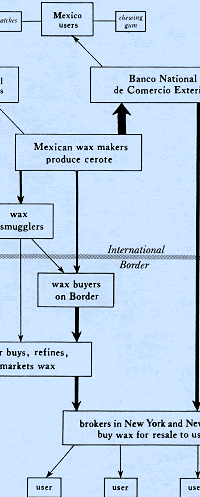
Marketing diagram for candelilla
wax, based on late 1970s economy and regulations. Although
the picture has changed, due to recent trade agreements
between the U.S. and Mexico, it is still as complex
as when Tunnell compiled this chart. Graphic courtesy
Texas Historical Commission. Click to enlarge.
|
|
"They always insist on coming in the middle
of the night, and I've worked all night inspecting shipments
many times. In the bags of cerote you often find what
are called "highballs," which are balls of
wet ashes covered in wax, and also rocks coated with
wax."
-Anonymous wax dealer in the 1970s.
|
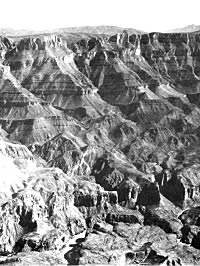
The rugged canyons of the Sierra
del Carmens support large stands of candelilla and were
the site of many wax camps. This photo at Boquillas
Canyon on the Rio Grande was taken by W.D. Smithers
from a small plane in 1936. Click to enlarge.
|
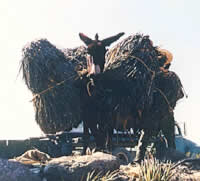
Sturdy burros saw heavy service as
pack animals during the era of the wax factories, as
they still do today. The animals hauled masses of carefully
packed candelilla from the canyon slopes to the factories
for processing. Photo by Glenn Evans, courtesy of the
Texas Memorial Museum.
|
|
"I can always tell when there is going to be
a wedding or a funeral across the river, because people
start bringing in a half bag of wax to get some cash."
-Candelária General Store operator Mrs. Walker,
1976.
|
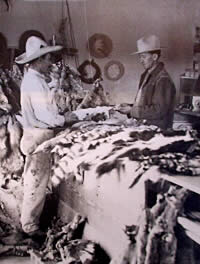
Workers brought furs, candelilla
wax, chino grass, and firewood to trade for necessities
such as sugar, flour, beans, and cloth at stores in
Glenn Springs and Castalon. Photo courtesy of Big Bend
National Park, NPS. Click to enlarge.
|
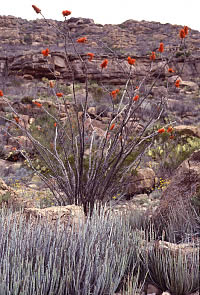
A red-blooming ocotillo plant adds
a touch of color to the grayish rocky slope. A stand
of candelilla is in forefront. Photo by JoAnn Pospisil.
Click to enlarge.
|
|
"There would be raids; and Maggie, hearing
the sound of approaching officials from the sensitive
acoustical position of her store, would hide any wax
in the ladies' restroom-a place that the border officials,
being gentlemen, never entered.."
-William O. Douglas in "A Farewell to Texas,"
1967.
|
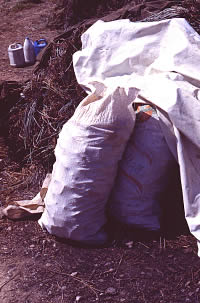
Bags of cerote, or raw wax. Photo
by JoAnn Pospisil.
|
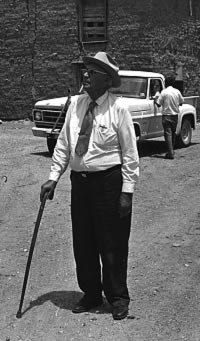
"Candelilla Wax King" J.E. Casner
in Candelária, Texas, 1976. The west Texas businessman
was still refining and marketing wax at the age of 88.
Photo by Curtis Tunnell, courtesy Texas Historical Commission.
|
|
When the "markets got sticky" in the east
in the 1960s, wax entrepreneur David Adams of Marathon
went to New York and met the wax brokers himself. His
profits on wax tripled when he started marketing it
himself.
|
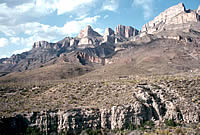
Foothills and escarpment of Sierra
del Carmen, Mexico. Photo by Raymond Skiles. Click to
enlarge.
|
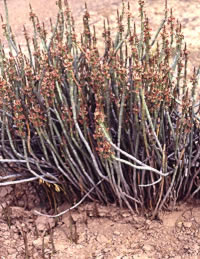
A candelilla plant in bloom. Photo
by JoAnn Pospisil. Click to enlarge.
|
|
